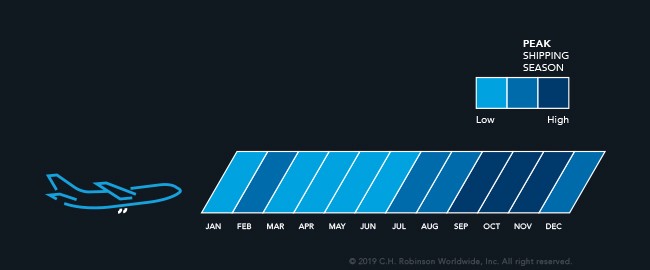
Reoccurring annual events, like the holiday season, typically bring predictability to air shipping. But lately, out of the ordinary events have disrupted the seasonality we typically expect. The best way to deal with the ever-changing peaks and valleys in air capacity throughout the year is to know both the historical patterns and potential air market disruptors.
The cyclical nature of air freight
Air freight service predictably follows the law of supply and demand. When shipping volumes spike, space on airlines becomes harder to secure and prices go up. And the opposite is true, too. If shipping volumes diminish, space on airlines becomes readily available and the prices go down.
As you might expect, the holiday peak season is one of the busiest shipping periods of the year around the world—including for air. But there are other seasonal surges to be aware of as well. The above below visually represents the seasonality of the air market in years’ past.
New disruptors to the air freight market
We’re just over halfway through 2019, and already it’s quite a different market than we’ve seen in the past. Several disruptors are causing a great deal of uncertainty.
Tariffs on Chinese goods
The ongoing trade war is one of the biggest disruptors to air shipping this year. Earlier tariff changes did not make a huge impact on air shipping. But demand for air freight shifted significantly when enough shippers preemptively repositioned inventory prior to the June 1, 2019, deadline. On May 31, 2019, the United States Trade Representative (USTR) announced the deadline would be extended to June 15, 2019.
Ecommerce and high-tech goods
With the growth of ecommerce and high-tech products flooding our markets, air freight is quickly becoming the go-to mode of transportation for many shippers—any time of year. Combined with the promise of two-day shipping, it’s often the only way to meet customer demands.
Adjust your air freight strategy based on the market
With air freight volumes lower than we’ve seen since the 2008 recession, now may be the ideal time to update your air freight shipping strategy.
Choosing air freight can be a strategic way to lower inventory levels in the United States. Finding a balance between inventory costs without sacrificing customer delivery expectations often requires expertise. The air experts at C.H. Robinson are available in offices around the globe to help manage your air freight and ensure any problems are resolved in real-time.
You may even consider that if air freight rates dip low enough, you could make up the difference (at least in part) of the added tariffs on Chinese goods.
The air freight market is a complex ecosystem that will likely remain uncertain for some time. While this uncertainty lasts, you may want to switch to a quarterly planning strategy to avoid a long-term commitment when you don’t know what’s coming.
What’s going to happen?
While inventories in the United States remain high, it’s likely that air shipping volumes will remain low. The best way to insulate your company and your relationships from today’s air market is to stay flexible. Adapt quickly to ensure you can take advantage of soft markets while still buying appropriately during peak seasons.




